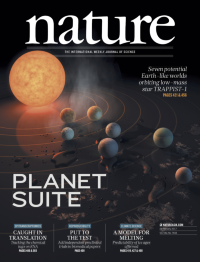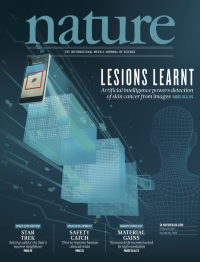Volume 542
-
No. 7642 23 February 2017
Michal Gillon et al. report the results of a photometric monitoring campaign of the star TRAPPIST-1 from the ground and space. They reveal that at least seven planets with sizes and masses similar to Earth revolve around this Jupiter-sized star. These planets all have equilibrium temperatures low enough to make it possible for liquid water to exist on their surfaces. The cover shows an artists interpretation of the seven planets and their relationship with TRAPPIST-1. Cover art: NASA/JPL-Caltech/Robert Hurt (IPAC).
-
No. 7641 16 February 2017
The cover shows women threshing quinoa in Perus highlands. In this issue, Mark Tester and colleagues report a reference genome for quinoa (Chenopodium quinoa), a highly nutritious crop that can grow under a wide range of environmental conditions. Long-read sequencing combined with optical, chromosome-contact and genetic maps was used to generate the allotetraploid genome. The authors also sequenced the genomes of additional diploid and tetraploid Chenopodium species, characterizing genetic diversity and the evolution of sub-genomes in the crop. In the process, Tester and colleagues identified a transcription factor that regulates the biosynthesis of bitter-tasting saponins in quinoa, as well as markers that might be used to develop sweet commercial varieties. Cover image: Lynn Johnson/National Geographic Creative.
-
No. 7640 9 February 2017
The cover shows a reconstruction of Saccorhytus coronarius, a newly identified deuterostome dating back to the earliest Cambrian period in China. Deuterostomes constitute an array of organisms as varied as vertebrates, starfish, acorn worms and tunicates. But this range of forms, and a lack of extant morphological intermediates, makes it difficult to understand what early deuterostomes were like. The tiny fossils described by Simon Conway Morris and his Chinese colleagues reveal creatures with bag-like bodies and no anus. The primitive features seen in the remains have led the researchers to interpret them as the most basal known deuterostomes, suggesting that their earliest history lies among the meiofauna. Cover image: Jian Han/Dinghua Yan.
-
No. 7639 2 February 2017
The cover shows how the detection of skin cancer could be simplified and extended by using artificial intelligence. Andre Esteva et al. used 129,450 clinical images of skin disease to train a deep convolutional neural network to classify skin lesions. The result is an algorithm that can classify lesions from photographic images similar to those taken with a mobile phone. The accuracy of the system in detecting malignant melanomas and carcinomas matched that of trained dermatologists. The authors suggest that the technique could be used outside the clinic as a visual screen for cancer. Cover: Dejapong I. Suwaratana & Uri Tzarnotzky.




